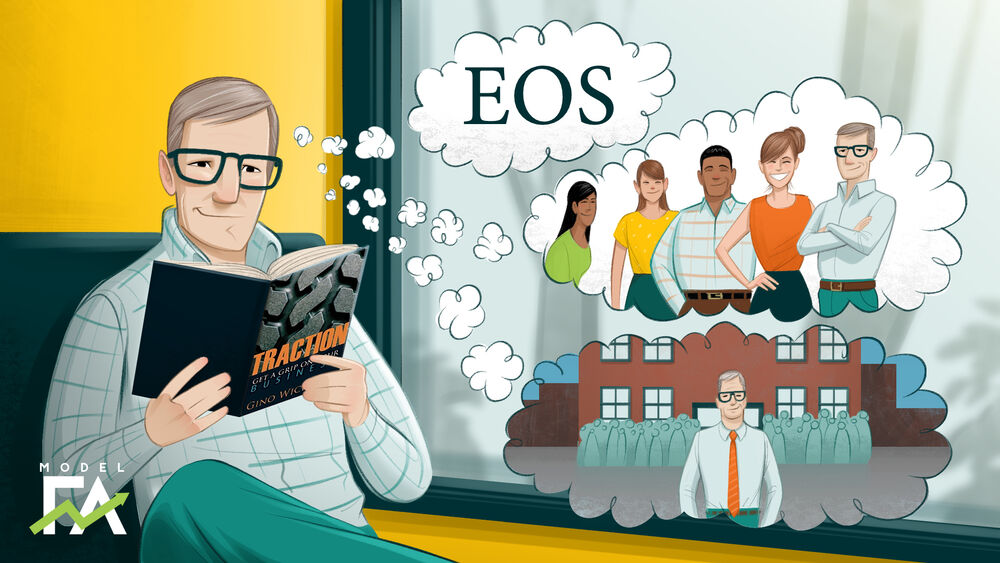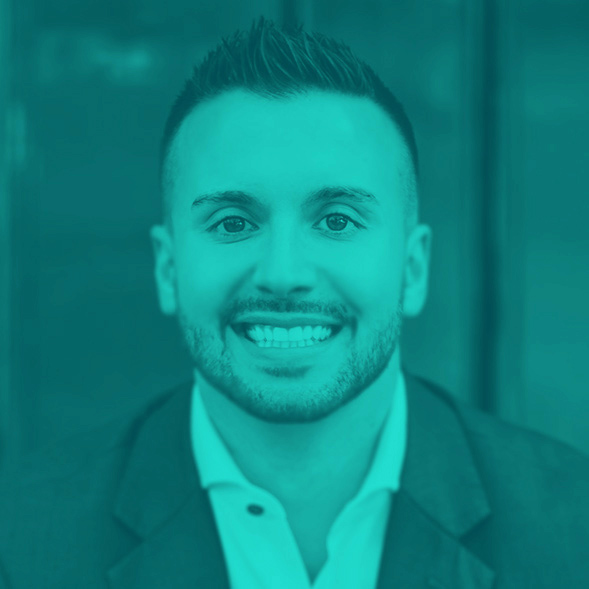3 Reasons Why Every Advisor Needs to Read Traction
06.05.21 | David DeCelle | 0 Scale
SUMMARY: Growing a business beyond one advisor is a dream for many. And yet, when it finally happens, many advisors feel lost. Sustainability at a higher scale is elusive, and it’s easy to feel like you have put in all this hard work just to work even harder. This is why I believe that every advisor needs to read Gino Wickman’s Traction. The book lays out the Entrepreneurial Operating System® (EOS), a way of thinking about the business that can help advisors build structure to take their practices to the next level.
Advisors are often told to simply put their noses to the grindstone when building up their practice. That type of effort builds good habits, resilience, and stamina — all good things.
However, as the practice grows and the advisor brings on more team members, they often find themselves in the position of an “accidental business owner.” One day, they wake up and realize that they are responsible for several employees, a large client base, and a complex set of business operations — which is enough to give anyone pause.
Most advisors who make it to this stage lean on the skills that have gotten them this far, which means that they continue working in their business. The trouble is that they don’t learn to work on their business. With no dedicated time to focus on business structure and high-level decisions (such as brand, marketing strategy, and investing in new tech), the business loses efficiency and can’t keep growing.
Enter one of my favorite books on running and growing a business: Gino Wickman’s Traction.
In Traction, Wickman introduces his Entrepreneurial Operating System, a simple framework that can help any entrepreneur — including a financial advisor — build structure into their business and restore that momentum they had initially.
The full EOS methodology introduced in Traction has several components, and it is worth picking up the book to see all of it. However, here are what I believe to be the most crucial points Wickman covers in the book.
The Importance of Holding the Three Visions
Wickman lays out three different visions you must have for your practice. These visions ensure that everyone in your practice is 100% clear and aligned on where the firm is headed and how it will get there.
The Ten-Year Vision
Creating your ten-year vision is the first step toward implementing the EOS approach in your practice because you reverse-engineer that vision to break it down into smaller steps. Your ten-year vision shouldn’t be longer than one or two sentences. It should be simple enough for everyone within the practice to understand.
Don’t be afraid to be bold with your ten-year vision, though. Setting a lofty but achievable vision will inspire your team to work through hard times and overcome challenging obstacles.
The Three-Year Vision
Now, you begin breaking that ten-year vision into smaller, more manageable parts — starting with the three-year vision.
The three-year vision is more granular than the ten-year vision. It includes specific goals for revenues, profits, and other metrics that will tell you that your business is moving forward. Next, you create a bulleted description out of these elements. The description should clearly communicate to everyone in the firm what you want it to look like three years from now.
The One-Year Vision
Next, EOS has you lay out your one-year vision for your firm. This one-year vision is driven by the three-year vision but is condensed and even more specific. That way, you can evaluate your accomplishments and check if you’re on track to meet your three-year vision.
The Quarterly “Rocks”
Compressing ten years into three years and one year can make everything seem like a priority. And if everything is your priority, then you don’t have any real or useful priorities. That’s why EOS breaks things down further into quarterly “Rocks.”
Your Rocks are the top three to seven things your team must accomplish within the next 90 days. Every quarter, the team should meet and (after reviewing last quarter’s achievements pertaining to Rocks) list everything the firm must accomplish in the next 90 days.
If you are meeting in person, this is a good time to use a white board. If your meeting is virtual, a shared Google document is a helpful alternative. The goal is to encourage each team member to discuss and debate each item, eliminating what matters less and helping the team settle on the set of true priorities for the next 90 days. Leadership then assigns Rocks to team members, sets due dates, and creates a Rock sheet containing these Rocks to share with the entire organization.
EOS mandates that each department should set its own Rocks as a team, too. These Rocks should contribute to the firmwide Rocks.
The team should meet at the end of each 90-day period to make sure everyone completed the Rocks on time. Then, you’ll do the quarterly Rock planning process all over again. The logic here is that the act of focusing on these Rocks quarter after quarter will eventually bring you to each of your longer-term company visions.
Additionally, Rocks create accountability. Each Rock should be owned by someone in the firm, ensuring that it gets completed on time.
The Level 10 Meeting
Finally, EOS helps you implement Level 10 meetings with your team. These are weekly, 90-minute meetings designed to check on progress toward accomplishing Rocks. You’ll also check in on your most important metrics, run through your to-do list for the Rocks, and identify and discuss issues, to name a few activities.
Because these meetings have a time limit, everyone in the organization is forced to keep things concise, and the team can focus on the most critical issues.
People: The Key to Making EOS Work
None of what I have covered so far is new. In fact, you have probably nodded along with every paragraph — because we all know that vision, goals, and accountability matter.
Which is why the human element of EOS is so important.
When an advisor works solo, he or she is in charge (and in control) of everything in the business. As that responsibility gets distributed, the outcome will depend largely on two factors.
- Right people: Did you hire the right people?
- Right roles: Did you place those people into their optimal roles for the firm’s success?
Those are simple questions, yet they can be surprisingly difficult to answer. Does this individual align with the core values of the organization? Do they have the technical knowledge requested to do the job well? Do they have a solid understanding of what it takes to be successful — and enough motivation to do the hard things that entails?
In my experience, the secret to making good alignment decisions with people is in addressing issues and concerns as they come up. Advisors get incredibly busy, and having a tough conversation with a staff member is not most people’s favorite thing to do. However, if you allow your frustration levels to build up, it will become virtually impossible to make the distinction between the right person in the wrong seat — and a wrong person altogether. As a result, you may lose a professional who could have contributed to your success.
Why Should Financial Advisors Look into EOS?
I see at least three reasons why every advisor should at least scan the EOS methodology.
- Even if you could figure this out on your own, structure and shortcuts help.
Becoming a business owner forces advisors to “grow” a new set of skills. They can do it through trial and error, or they can implement a comprehensive system that has been tested. If you want to skip a few bumps and bruises, the EOS resources can be a helpful starting point.
- It will help you build a stronger team.
Trust is an essential element of a functional team that’s working on something big. By having scheduled time to talk through what matters most, discuss surface issues, and work through problems together, your team members will develop a new level of respect and trust toward one another.
- It will put everyone on the same page.
When the whole team is in a regular conversation about goals, deadlines, and progress, it becomes impossible to hide behind excuses. Very quickly, the team will see those who are committed to the shared vision.
EOS: Related Reading
If you are interested in learning more about EOS, the original book Traction by Gino Wickman is a great place to start. There are a few more books that you may find helpful as you make your way through applying these concepts.
- The ONE Thing by Gary Keller (read if you need help getting to the core of what matters most). Essentialism by Greg McKeown is another good one to pick up.
- Topgrading by Bradford D. Smart (a hiring and promotion method for boosting your firm’s performance).
- Tribal Leadership by Dave Logan (read for practical, tactical advice on assessing the status quo of trust in your firm — and for the tools to elevate your team and the kinds of problems you solve).
- Reality-Based Leadership by Cy Wakeman (read if your firm has more human drama than you like, and if you are looking for a method that focuses on reality and results).
EOS Works for Firms of Any Size
One of the great things about the EOS methodology is that it works for firms of any size. My team has helped firms of all sizes, from practices with a single advisor to those with 100+ employees and staff, implement the EOS framework to great success. We can help you, too. Book a call here to get started: https://www.modelfa.com/accelerator-call-cf/
